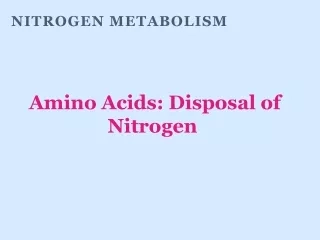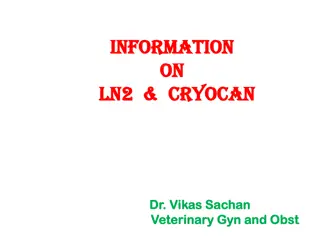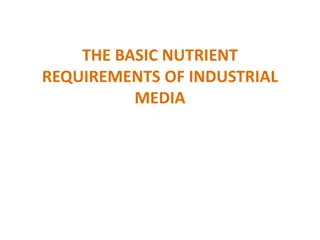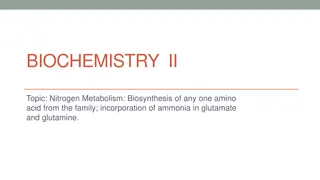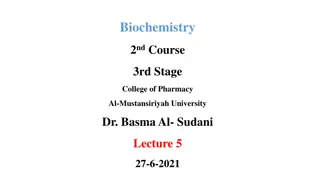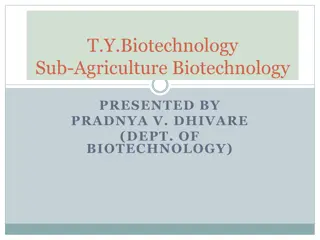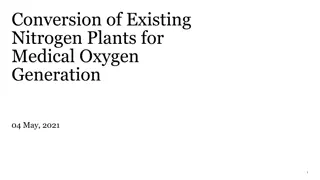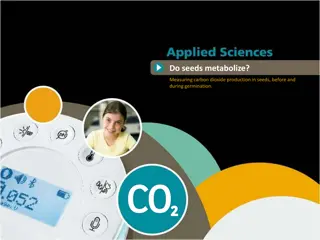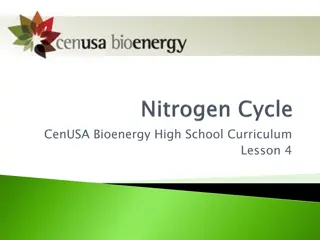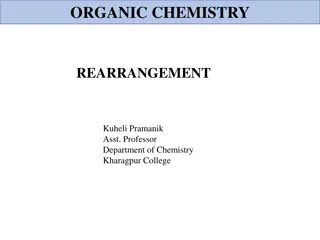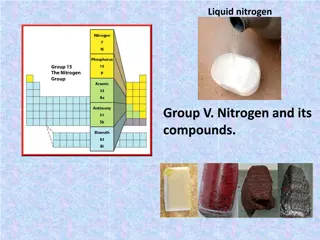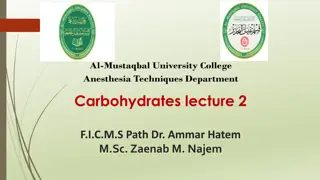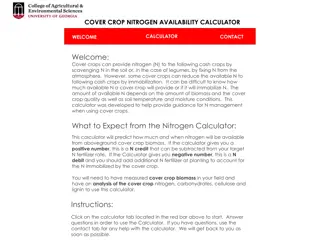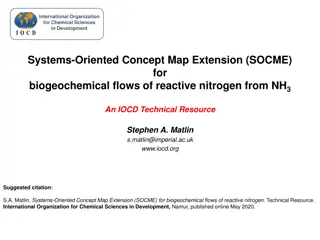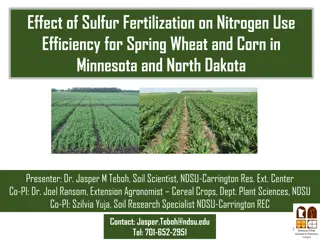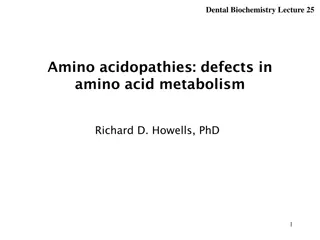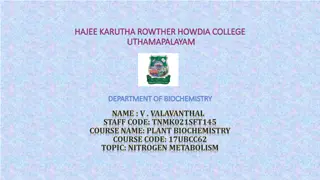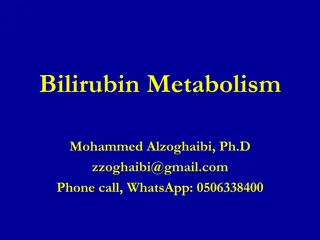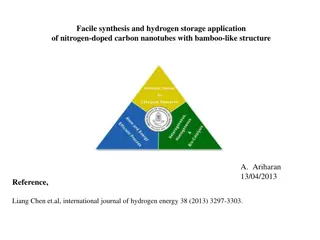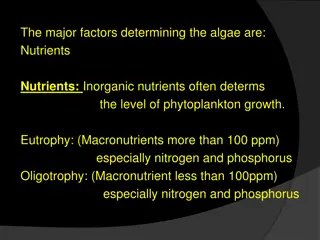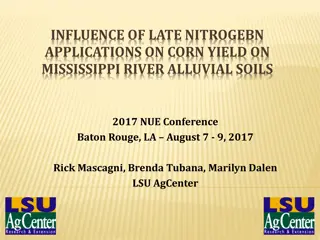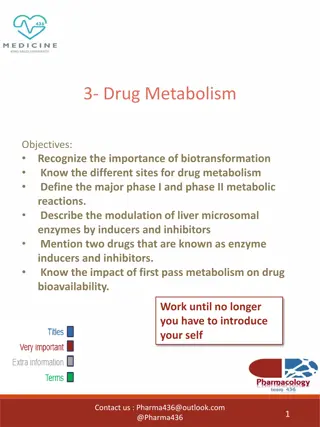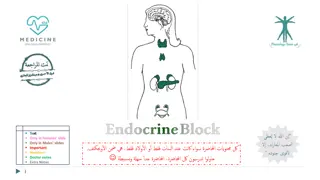Amino Acids: Disposal of Nitrogen
Overview of nitrogen metabolism with a focus on the disposal of nitrogen through amino acid catabolism. It explains the process of removing the α-amino groups from amino acids, the synthesis of urea, and the conversion of carbon skeletons to energy-producing pathways.
36 views • 65 slides
Essential Guidelines for Handling Liquid Nitrogen Containers
Learn about the safe handling and storage practices for liquid nitrogen containers such as LN2 cryocans and cylinders. Find out about the importance of maintaining vacuum systems, preventing frost lines, and ensuring proper transportation methods to avoid accidents and damage.
3 views • 20 slides
Protein Digestion and Metabolism in Ruminants and Non-Ruminants
Digestion and metabolism of protein in both ruminants and non-ruminants involve enzymatic breakdown of proteins into polypeptides and amino acids in the stomach and intestines. Key enzymes such as pepsin, trypsin, and chymotrypsin play important roles in protein digestion. Gastric digestion in the s
3 views • 14 slides
Understanding Nitrogen Fixation Process in Plants
Nitrogen fixation is the conversion of atmospheric nitrogen into ammonia or nitrates by bacteria or industrial processes for plant absorption. Biological and abiological methods exist, with various bacteria and cyanobacteria involved in the process. Symbiotic relationships between these organisms an
1 views • 10 slides
Nutrient Requirements of Industrial Media
Microbiological media for industrial and laboratory purposes need to provide essential nutrients like carbon, nitrogen, minerals, growth factors, and water while avoiding growth-inhibitory substances. Carbon, nitrogen, minerals, and growth factors play key roles in supporting microbial growth, and t
0 views • 25 slides
Understanding Nitrogen Metabolism: Amino Acid Biosynthesis and Ammonia Incorporation
Nitrogen metabolism is crucial in the biosynthesis of amino acids such as glutamate and glutamine, incorporating ammonia for various physiological processes. Ammonia is efficiently transported and stored using compounds like alanine and glutamate, playing a key role in the urea cycle. Glutamate, a v
0 views • 22 slides
Diverse Methods of Poultry Farming and Agricultural Practices
Poultry farming practices such as organic farming, nitrogen fixation, biodiversity management, and contract farming are discussed. Organic farming emphasizes holistic relationships in agriculture, promoting sustainable production. Nitrogen fixation and biodiversity management play essential roles in
0 views • 20 slides
Understanding Xenobiotic Metabolism for Biomedical Applications
Metabolism of xenobiotics, foreign chemicals like drugs, food additives, and pollutants, is crucial for pharmacology, toxicology, and disease management. Knowledge allows for beneficial applications such as antioxidant research, pollutant conversion, and drug biosynthesis using transgenic organisms.
0 views • 11 slides
Nitrogen Fixation and Symbiotic Relationship in Agriculture
Nitrogen fixation is a crucial process where nitrogen is converted into ammonia by nitrogen-fixing bacteria, benefiting plants like legumes. Symbiotic nitrogen fixation involves a mutualistic exchange between plants and bacteria, exemplified by Rhizobium species. This symbiosis leads to the conversi
0 views • 15 slides
Conversion of Nitrogen Plants for Oxygen Generation in Medical Industry
CPCB has identified industries with nitrogen plants that can be converted to produce oxygen without impacting normal operations. Conversion involves using Zeolite Molecular Sieve and PSA technology, with M/s. UPL Ltd successfully converting a plant at LG Rotary Hospital in Gujarat within 72 hours. S
0 views • 15 slides
Understanding Seed Metabolism: Measuring Carbon Dioxide Production Before and During Germination
Exploring the metabolic processes in seeds, this study aims to compare carbon dioxide production before and during germination. Students will hypothesize and verify using a carbon dioxide SensorLab sensor. Theoretical aspects of plant metabolism, including photosynthesis and cellular respiration, wi
1 views • 22 slides
Understanding Inborn Errors of Metabolism and Metabolic Disorders
Inborn Errors of Metabolism (IEM) are genetic disorders that disrupt metabolic pathways, leading to substrate accumulation or product deficiency. These disorders can be classified based on toxic accumulation, protein metabolism, carbohydrate intolerance, lysosomal storage issues, energy production d
0 views • 29 slides
Understanding the Nitrogen Cycle and Erosion Process
Nitrogen, a vital element found in living and non-living things, plays a key role in the nitrogen cycle where it moves between organisms and the environment. However, human activities like using nitrogen-rich fertilizers can lead to environmental issues like waterway pollution. In addition, the proc
2 views • 6 slides
Decarboxylation Reaction and Biogenic Amines in Amino Acid Metabolism
Decarboxylation is a crucial reaction in amino acid metabolism where CO2 is removed to form biogenic amines, catalyzed by decarboxylase enzymes. Important biogenic amines include tyramine, tryptamine, and histamine, each impacting physiological functions like blood pressure regulation. Aromatic amin
0 views • 25 slides
Hofmann Rearrangement: Mechanism, Stereochemistry, and Key Steps
The Hofmann rearrangement is a notable organic chemistry reaction that converts an amide into an amine with one less carbon atom. This process involves key steps such as bromination of nitrogen, extraction of H+ by OH-, and rearrangement of anion. The mechanism includes the formation of N-Bromoamide
6 views • 15 slides
Nitrogen Asphyxiation Hazards and Safety Tips
This safety moment highlights the dangers of nitrogen asphyxiation through a tragic incident and provides essential safety tips to prevent such accidents. It emphasizes the importance of proper ventilation in confined spaces, awareness of oxygen levels, and handling precautions for compressed gases.
0 views • 4 slides
Understanding Nitrogen: Properties, Reactions, and Applications
Nitrogen, a colorless and odorless gas, is a vital element present in air and plays a crucial role in various chemical reactions. Known for its unreactive nature due to strong bonds, nitrogen is used in the manufacture of ammonia, fertilizers, and organic compounds. Discover how nitrogen is prepared
0 views • 43 slides
Decoding Oxidative Decarboxylation and Krebs Cycle in Energy Metabolism
Explore the intricate processes of oxidative decarboxylation and the Krebs Cycle, essential pathways in cellular energy metabolism. Learn about the conversion of pyruvate to acetyl-CoA, regulatory mechanisms, clinical implications, and more. Discover the fates of pyruvate, allosteric regulation, and
6 views • 19 slides
Understanding Carbohydrate Metabolism and Diabetes Mellitus
Carbohydrates play a vital role in energy production through processes like glycolysis and gluconeogenesis. Glucose metabolism involves pathways like aerobic glycolysis and anaerobic lactate production. In diabetes mellitus, there is a disruption in carbohydrate metabolism leading to elevated blood
1 views • 14 slides
Surface Water-Groundwater Interactions and Nitrogen Cycling in a Tidally Influenced River Study
Study on the dynamic interactions between surface water and groundwater in a tidal river, focusing on nitrogen cycling. The research highlights the impact of tidal fluctuations on bank storage, nitrogen transformation, and nutrient cycling. Findings suggest that river discharge affects the exchange
1 views • 16 slides
Maximizing Nitrogen Efficiency in In-Season Applications
This study explores the timing of in-season nitrogen applications in agriculture to optimize yield and minimize nitrogen loss. Results show that early application is crucial to reduce nitrogen loss susceptibility. The research includes key plant growth stages, such as physiological maturity and side
0 views • 30 slides
Evolution of N-Rich Strip Adoption in N Management
The adoption of N-Rich Strip has transformed nitrogen management practices over the years. Starting from small applications in 2003 to widespread utilization across acres in Oklahoma and Kansas, the confidence in this approach has grown significantly. Farmers are advised to monitor N-rich strips and
0 views • 17 slides
Cover Crop Nitrogen Availability Calculator
Cover crops can impact nitrogen availability for cash crops. This calculator helps estimate nitrogen availability from cover crop biomass, guiding N management decisions. It requires data on cover crop biomass and composition. Positive values suggest a nitrogen credit, while negative values indicate
0 views • 7 slides
Systems-Oriented Concept Map Extension for Reactive Nitrogen Flows
International Organization for Chemical Sciences in Development presents a Systems-Oriented Concept Map Extension (SOCME) focusing on biogeochemical flows of reactive nitrogen from NH3. The concept explores core reaction subsystems, energy input subsystems, equilibrium conditions, and the integratio
0 views • 11 slides
Effect of Microgravity on Nitrogen Fixation in Red Clover Study
Investigating the impact of microgravity on nitrogen fixation in red clover at Johnson County Central High School in Tecumseh, NE. The experiment aims to determine if clover exposed to space conditions fixates nitrogen similar to Earth conditions, crucial for growing food in space. Hypothesis, exper
0 views • 8 slides
Effect of Sulfur Fertilization on Nitrogen Use Efficiency for Spring Wheat and Corn
This research project, conducted by Dr. Jasper M. Teboh and his team at NDSU, investigates the impact of sulfur fertilization on nitrogen use efficiency for spring wheat and corn in Minnesota and North Dakota. The study aims to determine if wheat or corn respond to sulfur application, how sulfur aff
0 views • 25 slides
Overview of Amino Acidopathies in Dentistry: Defects in Amino Acid Metabolism
This lecture discusses the various amino acidopathies, including phenylketonuria, albinism, alkaptonuria, maple syrup urine disease, and homocystinuria. It covers the metabolic defects in amino acid metabolism, symptoms, causes, and treatment methods for these disorders. Emphasizing the importance o
0 views • 19 slides
Microbial Transformations of Nitrogen in Soil: Factors, Forms, and Impact on Plant Nutrition
Understanding the microbial transformations of nitrogen in soil is crucial for optimizing plant nutrition. Factors such as climate, water supply, cultivation, soil texture, and depth influence the nitrogen content in soil. The different forms of soil nitrogen, including inorganic and organic compoun
0 views • 23 slides
Understanding Abiotic Cycles in Ecosystems: Hydrologic, Carbon, Nitrogen, and More
Abiotic cycles play a crucial role in regulating ecosystems. The hydrologic cycle involves processes like evaporation, condensation, precipitation, and transpiration. The carbon cycle relies on photosynthesis, respiration, and human activities like deforestation and burning fossil fuels. The nitroge
0 views • 20 slides
The Role of Nitrogen in Plant Biochemistry: Understanding Nitrogen Metabolism
Nitrogen is a crucial element in plant biochemistry, essential for protein synthesis and the formation of various organic compounds. This article explores the sources of nitrogen available to plants, including atmospheric nitrogen, nitrates, and organic nitrogen compounds. The importance of nitrogen
0 views • 15 slides
Understanding Methanol Metabolism and Blood Levels
This content discusses the difference between background/endogenous and exogenous methanol, how metabolism of endogenous methanol affects exogenous metabolism, and the impact of exposure to different levels of methanol on blood concentrations. It highlights EPA PBPK models and assumptions regarding
0 views • 16 slides
Understanding Bilirubin Metabolism in Human Body
Bilirubin, a key pigment in bile, is derived from heme breakdown and plays a crucial role in the liver's detoxification process. This article explores the metabolism of bilirubin, its relationship with heme and globin, as well as its excretion steps involving enzymatic reactions and conjugation in h
0 views • 31 slides
Nitrogen-Doped Carbon Nanotubes for Hydrogen Storage
Hydrogen is a promising energy carrier for the future, and efficient storage under ambient conditions is a key challenge. Nitrogen-doped carbon nanotubes show potential due to their unique structure and chemical properties. This study focuses on the facile synthesis and hydrogen storage application
0 views • 12 slides
Rice GHG Emissions under Varied Nitrogen, Variety, and Water Management Study in Arkansas
Detailed study on rice greenhouse gas emissions under varied nitrogen, variety, and water management treatments, focusing on nitrogen fertility, crop varieties, and water usage impact on methane and nitrous oxide emissions. Research examines optimal nitrogen rates for reduced global warming potentia
1 views • 18 slides
Factors Influencing Algae Growth in Water Ecosystems
Nutrients play a crucial role in algae growth, with inorganic nutrients like nitrogen and phosphorus being key factors. Algae require macroelements such as carbon, hydrogen, oxygen, sulfur, potassium, calcium, phosphorus, and nitrogen in large quantities, as well as microelements like iron, manganes
0 views • 16 slides
Influence of Late Nitrogen Applications on Corn Yield on Mississippi River Alluvial Soils - 2017 NUE Conference
Excessive rainfall in the lower Mississippi Delta can lead to late-season nitrogen deficiency in corn crops. Research conducted at the LSU AgCenter focused on evaluating the efficacy of supplemental nitrogen at late growth stages on Mississippi River alluvial soils. Field experiments from 2006 to 20
0 views • 19 slides
Understanding Drug Metabolism: Importance and Mechanisms
Drug metabolism is a crucial process in the body that transforms drugs into forms easily excreted, affecting their efficacy and toxicity. This involves different sites such as the liver, kidney, and plasma, with enzymes in cellular organelles like cytoplasm and mitochondria playing key roles. First-
0 views • 13 slides
Understanding Drug Metabolism and Excretion in Pharmacology
Drug metabolism involves the biotransformation of pharmaceutical substances in the body, primarily in the liver, to facilitate their elimination. This process helps convert drugs into less active forms for enhanced elimination through various reactions in Phase I and Phase II metabolism. Factors suc
0 views • 20 slides
Understanding Parathyroid Disorders - Calcium Metabolism and Hormonal Regulation
This presentation covers the functions of calcium, calcium metabolism, bone physiology, and hormonal regulation of calcium metabolism focusing on parathyroid hormone, calcitonin, and Vitamin D. It discusses hypo and hyperparathyroidism in detail, including clinical manifestations and treatment optio
0 views • 15 slides
Understanding Newer Antianginals and Cardiomyocyte Metabolism
Chronic angina is a condition marked by impaired quality of life and decreased life expectancy, primarily due to myocardial ischemia. It is characterized by symptoms like tightness, heaviness, and pressure sensation, often located retrosternally. The pathophysiology involves a mismatch between oxyge
0 views • 73 slides
